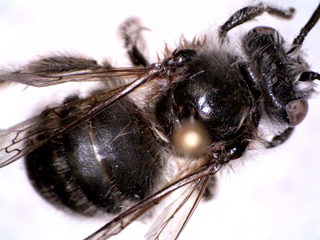
David Biddinger · 9
Melissodes fimbriatus, male top view |
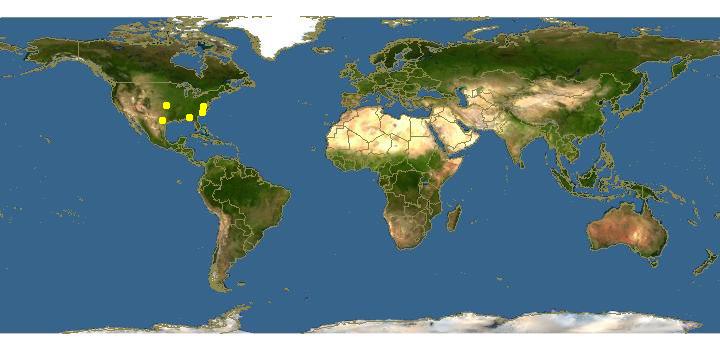
Click on map for details about points.
|
| Links | Reprinted with permission from: Mitchell, T.B. 1962 Bees of the Eastern United States. North Carolina Agricultural Experiment Station Technical Bulletin No. 152.
FEMALE�Length 11-12 mm., breadth of abdomen 4 mm.; black, the mandibles pale yellowish apically; segments of flagellum beyond the 2nd brownish-piceous beneath, black above; apical tarsal segments brownish-testaceous, and spurs pale yellowish; tegulae black, strongly narrowed anteriorly; wings subhyaline basally, becoming lightly infuscated apically, veins brownish to piceous; cheeks subequal to eyes in width, clypeus only slightly protuberant, its median length slightly greater than distance between eyes below; eyes very slightly convergent below; basal segment of flagellum about one and one half times segment 2, which is somewhat longer than broad; punctures of clypeus quite coarse and very close, becoming finer and densely crowded apically, the labrum more shallowly rugoso-punctate; face laterally with fine and close punctures, these becoming rather sparse above where surface is shining, somewhat coarser medially, fine and close on vertex back of ocelli, becoming more widely separated laterally and on cheeks; scutum and scutellum shining, punctures deep and distinct, rather coarse and well separated on scutum medially, becoming close and somewhat finer laterally and anteriorly, evenly distributed on scutellum; mesopleura rather coarsely, closely and shallowly punctate; posterior face of propodeum quite coarsely but shallowly punctate, becoming rather sparsely so above, dorsal area impunctate along mid-line, becoming dull and densely rugoso-punctate laterally, lateral faces quite uniformly closely punctate throughout; anterior half of basal abdominal tergum rather dull, punctures shallow but rather coarse and well separated medially, becoming closer and finer laterally, disc rather broadly impunctate across apical third; terga 2 and 3 more finely, deeply and distinctly punctate, well separated medially-, becoming quite close at extreme sides and quite close over most of tergum 4; tergum 5 densely and rather finely rugoso-punctate; pygidium quite narrow and elongate, nearly parallel-sided, with a narrowly rounded apex; pubescence whitish in general on head, with a few dark hairs across vertex; scutum and scutellum with copious, erect, fuscous pubescence, scutum narrowly pale pubescent across anterior margin, and the entire pleura propodeum and legs pale pubescent; tibial scopa pale ochraceous, hairs slender, elongate and simple, without evident plumosities; basal abdominal tergum with rather copious, elongate, pale pubescence across base and along lateral margins; tergum 2 with a basal fringe of rather loose, whitish, plumose hairs, usually covered by the apical part of tergum 1; terga 2-4 with whitish, subapical fasciae that occupy the rather narrow, apical, impressed areas, disc of tergum 2 with very- short, thin, whitish hairs and a few dark hairs at each extreme side, 3 and 4 with somewhat more conspicuous and erect blackish pubescence which overlies in part the apical fascia; tergum 5 largely fuscous or blackish pubescence this becoming pale to some degree at each extreme side, forming a dense apical fimbria.
MALE�Length 9-10.5 mm., breadth of abdomen 3.5-4 mm.; black, clypeus bright yellow, labrum and mandibles entirely black, flagella brownish-testaceous beneath, more piceous above, apical tarsal segments somewhat more piceous, and spurs brownish-testaceous; tegulae black, strongly narrowed anteriorly; wings very- faintly infuscated basally, becoming somewhat more deeply so apically, veins brownish to piceous; apical margins of terga 2-5 obscurely yellowish-hyaline; cheeks considerably narrower than eyes, clypeus somewhat protuberant, its median length considerably greater than half the distance between eyes below; eyes somewhat convergent below; shorter side of basal segment of flagellum very slightly longer than pedicel, segment 2 about five times as long; punctures of clypeus rather fine and close, somewhat deeper and more distinct on labrum; face laterally rather dull and finely punctate below antennae, punctures becoming somewhat more sparse above, close, deep and distinct on vertex medially, more widely separated laterally and on cheeks; scutum and scutellum shining, punctures deep, distinct and rather coarse, well separated on scutum medially; pleura quite dull, somewhat more shining anteriorly; punctures shallow but quite coarse and close; posterior face propodeum somewhat shining, punctures rather shallow but coarse and somewhat separated medially, becoming closer laterally and on lateral faces, dorsal area distinctly punctate medially, becoming rugose at each side; basal abdominal tergum with rather deep and distinct, moderately coarse, well separated punctures medially, becoming closer laterally and somewhat closer and finer toward the narrow impunctate apical margin; discs of terga 2-4 with quite deep, distinct and rather sparse punctures medially, these becoming somewhat closer laterally, rather abruptly densely crowded along margin of the impunctate, depressed apical margins; terga 5 and 6 more finely and closely punctate, becoming densely so on 6 laterally; tergum 5 with an obscure angle on each extreme side; tergum 6 with a corresponding, rather slender, subtriangular, spine- like projection; scutum and scutellum with abundant, rather long and erect, blackish pubescence, scutum with whitish pubescence anteriorly, which extends along lateral margins to the propodeum; head, thorax and legs otherwise whitish pubescent; abdominal terga 1 and 2 entirely pale pubescent, 2 with a thin, basal, white fascia, usually covered by rim of tergum 1, terga 2-5 with whitish fasciae occupying the rather narrow, depressed, apical margins of each; discs of terga 3-6 with rather abundant, erect, black pubescence; tergum 6 not fasciate, fully exposed to apical rim; pygidial plate strongly elevated basally, with subparallel, lateral, carinate margins, abruptly constricted before apex which is rather broadly subtruncate; sterna 7 and 8 and genital armature as shown (fig. 83).
DISTRIBUTION�Virginia to Georgia, west to Texas and Kansas, April to July.
FLOWER RECORDS � Females visit Oenothera, in North Carolina chiefly O. laciniata, but males have been collected on Helianthus and Kneiffia.
|
80x5 -
240x3 -
240x4 -
320x1 -
320x2 -
320x3 -
640x1 -
640x2
Set display option above.
Click on
images to enlarge. |
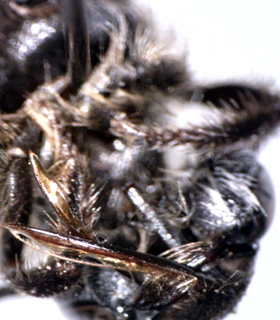
David Biddinger · 5
Melissodes fimbriatus, female, smooth, long galea1 |
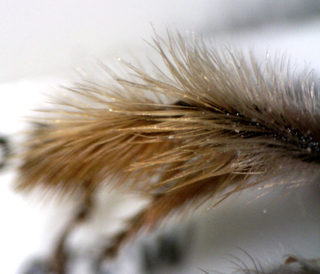
David Biddinger · 5
Melissodes fimbriatus, female legs, scopal hairs mostly simple, unbranched |
|
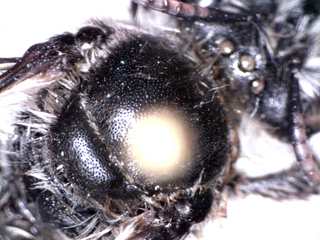
David Biddinger · 5
Melissodes fimbriatus, female scutum pitting |
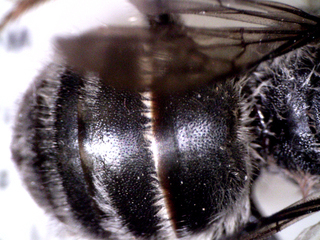
David Biddinger · 5
Melissodes fimbriatus, female top view, T1 T2 punctation and smooth impressed areas, hair bands on rim |
|
Names | |
|
|
|
Geographic distribution | |
Extracted from: LaBerge, W. E. 1963. New Species and Records of Little-known Species of Melissodes from North America (Hymenoptera: Anthophriadae). Bulletin of The University of Nebraska State Muesem, Vol. 4. Pp 227-242.
Two new records of this relatively rare species have come to the
attention of the author. These are as follows: TEXAS: Bexar
County: I ~,no other data. Laraca County: 1 ~, April 12, 1956, on
Oenothel'a sp., A. H. Alex. These specimens are in the collection of
Texas Agriculture and Mechanical Arts College at College Station.
|
|
| Supported by | |
Updated: 2024-04-18 12:09:10 gmt
|